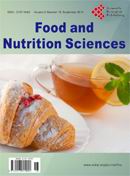 A nutrition journal is retracting a paper about potential dangers of eating food containing genetically modified organisms (GMOs) for duplicating a figure, as news stories from Italy are reporting accusations that the last author falsified some of his research.
A nutrition journal is retracting a paper about potential dangers of eating food containing genetically modified organisms (GMOs) for duplicating a figure, as news stories from Italy are reporting accusations that the last author falsified some of his research.
In the paper, Federico Infascelli, an animal nutrition researcher at the University of Naples, and his colleagues showed modified genes could wind up in the blood and organs of baby goats whose mothers ate GM soybeans. According to our Google Translate version of an article by Italian newspaper La Repubblica, an investigation suggests that Infascelli has manipulated images to suggest GMOs are harmful. He could face fines and be suspended from the university.
La Repubblica reports that a committee appointed by the rector of the university, Gaetano Manfredi, found errors in Infascelli’s data that suggested he had manipulated the results to show GMOs were harmful.
One paper by Infascelli has been retracted from Food and Nutrition Science, “Gamma-Glutamyl Transferase Activity in Kids Born from Goats Fed Genetically Modified Soybean.” The retraction note says the paper was pulled for duplication:
The article has been retracted due to the investigation of complaints received against it. The data of figure 1(b) came from the previous published paper by Tudisco R, Mastellone V, Cutrignelli MI, Lombardi P, Bovera F, Mirabella N, Piccolo G, Calabrò S, Avallone , Infascelli F. Animal.“Fate of transgenic DNA and evaluation of metabolic effects in goats fed genetically modified soybean and in their offsprings”4(10):1662-71, 2010. The scientific community takes a very strong view on this matter and we treat all unethical behavior such as plagiarism seriously.
The journal is not indexed in Thomson Scientific’s Web of Knowledge.
News reports from Italy mention that three papers are part of the investigation; we don’t know the names of the papers, but they were published in FNS, Animal, and Small Ruminant Research. There are PubPeer comments on Infascelli’s papers published in each of these journals suggesting image manipulation, including on the retracted paper and the paper referenced in its retraction note.
A retraction checklist preceding the PDF of the FNS paper connects it to the investigation, noting it was retracted by the “Editor with hints from” Italian Senator and stem cell researcher Elena Cattaneo. According to Il Foglio (again using Google Translate), Cattaneo started digging into Infascelli’s work following a debate in the senate on GMOs. She questioned Infascelli’s methods, and, using image analyzing software, found that some of the figures in his work had been manipulated.
According to La Repubblica, Infascelli will have time to respond to the accusations of manipulation before the university requests retractions of the other papers.
Hat tip: Commenter
Like Retraction Watch? Consider making a tax-deductible contribution to support our growth. You can also follow us on Twitter, like us on Facebook, add us to your RSS reader, and sign up on our homepage for an email every time there’s a new post. Click here to review our Comments Policy.
http://www.scirp.org/Journal/PaperDownload.aspx?paperID=33017
The notice goes on about “plagiarism” but the box for it has not been ticked in the notice. Only “self plagiarism” has. So I maintain the notice should be rewritten.
To me it seems sensible to show a relevant diagram again.
And please note, other boxes checked: Results still valid, Honest error.
Considering the PubPeer comments for this paper(https://pubpeer.com/publications/903F7BF22D3C8C46EA499B0C299A23)
“honest error” would then have to be accidentally taking the wrong picture of a gel, one that was published before and contained different samples. If so, surely they could have provided the right one, no?
Then again, this is a paper in a SCIRP journal, and there is a good chance they did not even contact the authors.
I look forward to follow-up on this.
Concerns with papers by these authors and GM soybean use in goat feed reported in early December at RW:
http://retractionwatch.com/2014/01/25/weekend-reads-trying-unsuccessfully-to-correct-the-scientific-record-drug-company-funding-and-research/#comment-858429
Well, “honest error” and “results of publication still valid” then what is the noise about? Politics or science or economics? Elena Cattaneo should also publish her own findings for us to see! Well, hope we would have a follow-up on this as I guess the outcome would be interesting.
Your readers may be interested in this detailed report of the alleged fraud, including the images in question. http://www.biofortified.org/2016/01/italian-research-group-subject-of-data-fabrication-probe/
My concern is with the goats. Was any part of the paper’s claims that “showed modified genes could wind up in the blood and organs of baby goats whose mothers ate GM soybeans” valid? In other words, even though the papers were pulled for figure manipulation, is there any truth in the risk of GM soybeans? Some background reading on GM soybeans:
https://en.wikipedia.org/wiki/Genetically_modified_soybean
Has there been a conclusion to this investigation?
http://www.nature.com/news/image-search-triggers-italian-police-probe-1.14295
…or this one?
http://retractionwatch.com/2012/01/30/university-of-perugia-researcher-faces-trial-for-embezzlement-and-fraud-following-13-retractions-and-expressions-of-concern/
Yes: Italian newspapers announced today that the investigation concluded that the researchers falsified data. (the news are in Italian sorry)
http://napoli.repubblica.it/cronaca/2016/02/09/news/universita_-133079638/
The translation says it is very unlikely that it was a mistake. In future they have to have all their wotk checked over by superiors. Does that mean censored?
No it means checked over. That would mean ensuring data presented is valud and is only used to support justified conclusions. They’ll also probably catch a few typos.
looks like there’s been an update on examination of the paper and others from the group.
http://www.examiner.com/article/anti-gmo-fraud-scandal-deepens